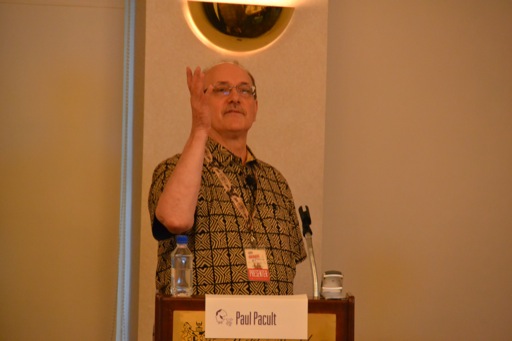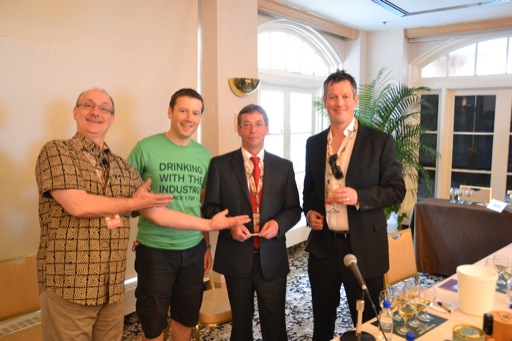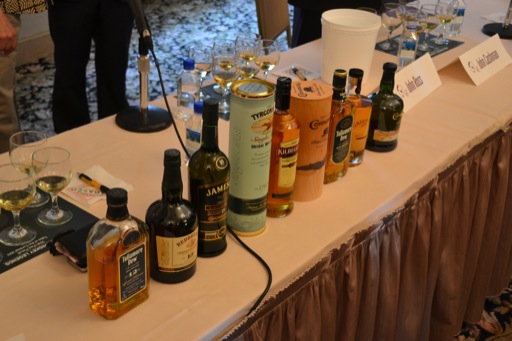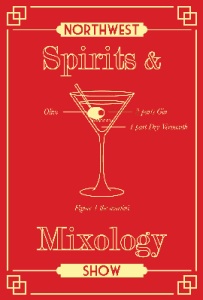Irish Whiskey Legends With Paul Pacault
August 2, 2011 by The Boozeniks
Filed under Spirits Events
 There are few surviving distilleries in Ireland. As spirits’ critic Paul Pacault put it, Irish Whiskey almost died. Between World War I, American Prohibition, and the Irish civil war, little of Ireland’s distillery business was left untouched. But now, it’s positively surging, and is one of the fastest growing spirits categories in the world. Why is that? It’s a sweeter whiskey than many, and that matches the younger generation’s palates. Another factor that probably plays into that generational popularity is that it’s not what their parents drank (Scotch).
There are few surviving distilleries in Ireland. As spirits’ critic Paul Pacault put it, Irish Whiskey almost died. Between World War I, American Prohibition, and the Irish civil war, little of Ireland’s distillery business was left untouched. But now, it’s positively surging, and is one of the fastest growing spirits categories in the world. Why is that? It’s a sweeter whiskey than many, and that matches the younger generation’s palates. Another factor that probably plays into that generational popularity is that it’s not what their parents drank (Scotch).
So now Irish whiskey is growing vibrantly. Jameson’s has had double digit growth for years, and there are rumors of 5-7 new boutique distilleries being established. All this demand means money, and that gives the distilleries enough economic breathing room to begin to experiment and differentiate. For example, Connemara is experimenting with wood finishes: Madeira and others’ including bog oak, which are trees that fell hundreds or even thousands of years ago, and have been preserved in the peat bogs. Cooley is importing French non-GMO corn for their single grain whiskey. And both Cooley and Connemara are reviving the pre-1960s practice of using peated malted barley for others.
Before going into the tastings, Paul reminded us that nearly all Irish whiskey is made in pot stills rather than column stills, and while it’s not made from only malted grains, it is otherwise created like a malt whiskey would be. The mash bill is not regulated, currently, but a new category (likely “single pot still”) is being discussed to help clarify.
 He and his panel then led us a through a tasting tour of a few favorites of his to show off some of the breadth of Irish whiskey today. I’ve included a couple notes on each to pique your curiosity and encourage you to find out about some of these whiskies for yourself, not that you’d likely need prompting.
He and his panel then led us a through a tasting tour of a few favorites of his to show off some of the breadth of Irish whiskey today. I’ve included a couple notes on each to pique your curiosity and encourage you to find out about some of these whiskies for yourself, not that you’d likely need prompting.
Tullamore Dew: bright, spicy, Christmas cake, with vanilla, citrus
Tullamore 12: gains sherry notes, a touch of sulfur, and more richness
Redbreast 15: awesome, rich, citrus, dark cherry, lingering wood and sherry, earthiness, cooked fruits, pot still mash bill of barley and malted barley, with much more sherry and wood from the additional maturation past the more usual 12-year Redbreast.
Jameson 18: this is a pot still whiskey blended with a grain whiskey, finish for 6 months in one-use American barrels. Sherry, cooked apples, caramel, toffee.
Connemara: As I mentioned above, some distillers are experimenting with peating their barley. Irish whiskeys were peated, up until the 60s. So, this is a revival, rather than anything really new. Distillers in Ireland must do lighter amounts of peat (40ppm) than a Scotch, since the base spirit is more delicate than the base in most peated Scotches. The Connemara cask strength we tried was a mix of 4, 6, and 8 years. The reason for the mix is to have the youthful exuberance of the 4 year, and the sweetness of the 8 year. The 6 year is a bridge. It had notes of peat, obviously, vanilla, and some nice spice. There is rumor of a small batch upcoming of a 4-year whiskey from Connemara with 54ppm of peat, because of a screwed up peated barley order.







